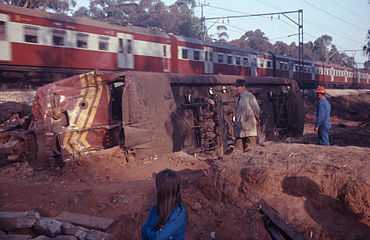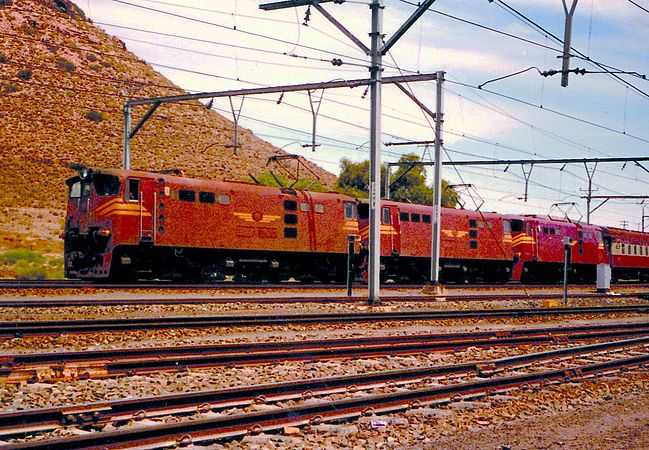South African Class 5E, Series 2
| South African Class 5E, Series 2 | |
|---|---|
|
Numbers E326, E319 and E297 leaving Touws River, circa September 1984 | |
| Type and origin | |
| Power type | Electric |
| Designer | English Electric |
| Builder | Vulcan Foundry |
| Serial number | EE 2421-2465, VF E149-E193 [1] |
| Model | EE 5E |
| Build date | 1956-1957 |
| Total produced | 45 |
| Specifications | |
| UIC classification | Bo-Bo |
| Gauge | 3 ft 6 in (1,067 mm) Cape gauge |
| Bogies | 3.430 m (11 ft 3 in) wheelbase |
| Wheel diameter | 1,219 mm (48 in) |
| Wheelbase | 11.279 m (37 ft 0.1 in) |
| Length | 15.494 m (50 ft 10 in) |
| Width | 2.896 m (9 ft 6 in) |
| Height | 4.089 m (13 ft 5 in) pantographs down |
| Axle load | 21,591 kg (21.3 long tons) |
| Locomotive weight | 86,364 kg (85 long tons) |
| Current collection method | Pantographs |
| Traction motors | Four EE 529 |
| Transmission | 18/67 gear ratio |
| Performance figures | |
| Maximum speed | 97 km/h (60 mph) |
| Power output |
Per motor: 377 kW (506 hp) 1 hour 325 kW (436 hp) continuous Total: 1,508 kW (2,022 hp) 1 hour 1,300 kW (1,700 hp) continuous |
| Tractive effort |
200 kN (45,000 lbf) starting 128 kN (29,000 lbf) 1 hour 104 kN (23,000 lbf) continuous |
| Locomotive brake | Air & Regenerative |
| Train brakes | Vacuum |
| Career | |
| Operator(s) |
South African Railways Spoornet Impala Platinum Driefontein |
| Class | Class 5E |
| Power class | 3 kV DC |
| Number in class | 45 |
| Number(s) | E319-E363 [2] |
| Nicknames | Balstamper |
| Delivered | 1957-1958 |
| First run | 1957 |
The South African Class 5E, Series 2 of 1957 is a South African electric locomotive from the South African Railways era.
In 1957 and 1958 the South African Railways placed forty-five Class 5E, Series 2 electric locomotives with a Bo-Bo wheel arrangement in mainline service.[2]
Manufacturer
The 3 kV DC Class 5E, Series 2 electric locomotive was built for the South African Railways (SAR) by Vulcan Foundry (VF) on a sub-contract from English Electric (EE), who designed the locomotive and supplied the electrical equipment. Forty-five series 2 locomotives were delivered and placed in service in 1957 and 1958, numbered in the range from E319 to E363.[1][3]
Orientation
These dual cab locomotives have a roof access ladder on one side only, just to the right of the cab access door. The roof access ladder end is marked as the number 2 end. A passage along the centre of the locomotive connects the cabs, which are identical except that Cab 2 is where the handbrake is located.[2]
Brakes
While the locomotive itself used air brakes, it was only equipped to operate trains with vacuum brakes. While hauling a train, the locomotive's air brake system would be made subordinate to the train's vacuum brake system and would come into operation as the vacuum brakes were being applied, gradually building up to its maximum of 350 kilopascals (51 pounds per square inch). While working a train downgrade, the locomotive's regenerative braking system would also work in conjunction with the train's vacuum brakes.
The locomotive's air brakes would usually only be used along with the train brakes during emergencies. Under normal circumstances the train would be controlled using the train brakes alone to slow down and stop.
While the locomotive was stopped, the air brakes on each bogie could be applied independently. The handbrake or parking brake, located in Cab no. 2, only operated on the unit's last axle, or no. 7 and 8 wheels.
Class 5E series
_ID.jpg)
The Class 5E was produced in three series, the EE and VF built Series 1 and the VF built Series 2 and Series 3. The VF built locomotives all have a works number for EE as well as VF, since the order was placed with EE who then subcontracted their construction to VF. Between 1955 and 1959 altogether one hundred and sixty Class 5E locomotives were delivered, sixty Series 1, forty-five Series 2 and fifty-five Series 3.[1][2][3]
According to crews the Class 5E gave a rough ride, which soon earned it the nickname balstamper. The successor Class 5E1 with its new design bogies gave a smoother ride.
Legacy
The Class 5E introduced a locomotive body shape that eventually became the most prolific to ever run on South African rails, serving on all the 3 kV DC lines country-wide. The body shape and dimensions were continued with the Class 5E1 in 1959, the Class 6E and the Class 6E1 from 1969 to 1985, and still later with the rebuilding of Class 6E1 locomotives to Class 18E, a project that was begun in 2000.[2][3][4]
Industrial service
Three Class 5E, Series 2 locomotives were sold into industrial service.
- Number E320 was sold to the Impala platinum mine in Rustenburg.
- Numbers E343 and E356 were sold to the Driefontein gold mine near Carletonville.[1]
Works numbers
The EE and VF works numbers of the Class 5E, Series 2 and their disposal are shown in the table.[1]
Loco no. |
EE works no. |
VF works no. |
Sold to |
|---|---|---|---|
| E319 | 2421 | E149 | |
| E320 | 2422 | E150 | Impala |
| E321 | 2423 | E151 | |
| E322 | 2424 | E152 | |
| E323 | 2425 | E153 | |
| E324 | 2426 | E154 | |
| E325 | 2427 | E155 | |
| E326 | 2428 | E156 | |
| E327 | 2429 | E157 | |
| E328 | 2430 | E158 | |
| E329 | 2431 | E159 | |
| E330 | 2432 | E160 | |
| E331 | 2433 | E161 | |
| E332 | 2434 | E162 | |
| E333 | 2435 | E163 | |
| E334 | 2436 | E164 | |
| E335 | 2437 | E165 | |
| E336 | 2438 | E166 | |
| E337 | 2439 | E167 | |
| E338 | 2440 | E168 | |
| E339 | 2441 | E169 | |
| E340 | 2442 | E170 | |
| E341 | 2443 | E171 | |
| E342 | 2444 | E172 | |
| E343 | 2445 | E173 | Dries |
| E344 | 2446 | E174 | |
| E345 | 2447 | E175 | |
| E346 | 2448 | E176 | |
| E347 | 2449 | E177 | |
| E348 | 2450 | E178 | |
| E349 | 2451 | E179 | |
| E350 | 2452 | E180 | |
| E351 | 2453 | E181 | |
| E352 | 2454 | E182 | |
| E353 | 2455 | E183 | |
| E354 | 2456 | E184 | |
| E355 | 2457 | E185 | |
| E356 | 2458 | E186 | Dries |
| E357 | 2459 | E187 | |
| E358 | 2460 | E188 | |
| E359 | 2461 | E189 | |
| E360 | 2462 | E190 | |
| E361 | 2463 | E191 | |
| E362 | 2464 | E192 | |
| E363 | 2465 | E193 | |
Liveries illustrated
The main picture shows Series 2 numbers E326 and E319 and Series 1 number E297 departing Touws River, heading northeast towards Beaufort West in September 1984. The following pictures depict the SAR Gulf Red and the Driefontein mine liveries. An overhead view of the locomotive is shown in a picture taken at an accident scene near Olifantsfontein in 1975.
-

No. E345 with Series 1 no. E295 in the Table Bay Docks, c. 1984
-

No. E348 wrecked near Olifantsfontein, Transvaal, c. July 1975
-
.jpg)
Driefontein Gold Mine no. 3, ex SAR no. E356, Carletonville, 21 January 2009
See also
- Electric locomotive numbering and classification
- List of South African locomotive classes
- South African Class 5E, Series 1
- South African Class 5E, Series 3
- South African locomotive history
References
|
- ↑ 1.0 1.1 1.2 1.3 1.4 Middleton, John N. (2002). Railways of Southern Africa Locomotive Guide - 2002 (as amended by Combined Amendment List 4, January 2009) (2nd, Dec 2002 ed.). Herts, England: Beyer-Garratt Publications. pp. 50, 62.
- ↑ 2.0 2.1 2.2 2.3 2.4 South African Railways Index and Diagrams Electric and Diesel Locomotives, 610mm and 1065mm Gauges, Ref LXD 14/1/100/20, 28 January 1975, as amended
- ↑ 3.0 3.1 3.2 Paxton, Leith; Bourne, David (1985). Locomotives of the South African Railways (1st ed.). Cape Town: Struik. pp. 127–128. ISBN 0869772112.
- ↑ Dulez, Jean A. (2012). Railways of Southern Africa 150 Years (Commemorating One Hundred and Fifty Years of Railways on the Sub-Continent - Complete Motive Power Classifications and Famous Trains - 1860-2011) (1st ed.). Garden View, Johannesburg, South Africa: Vidrail Productions. p. 292. ISBN 9 780620 512282.
